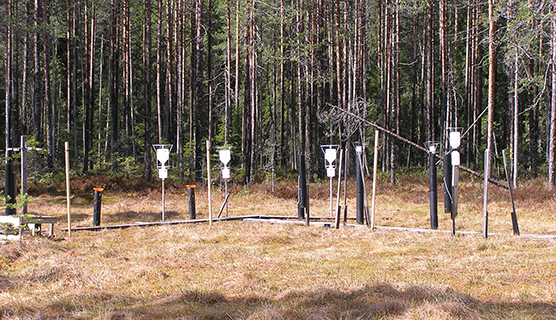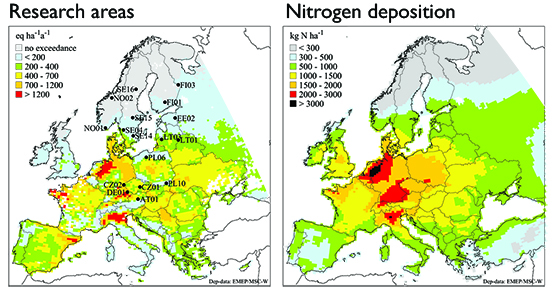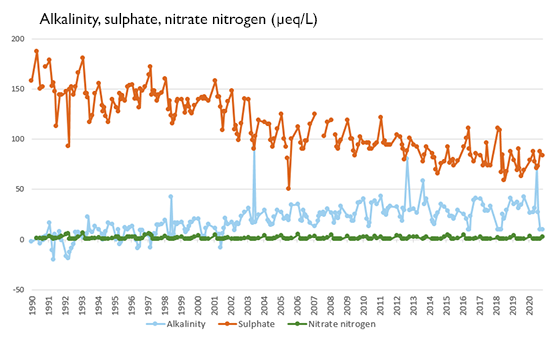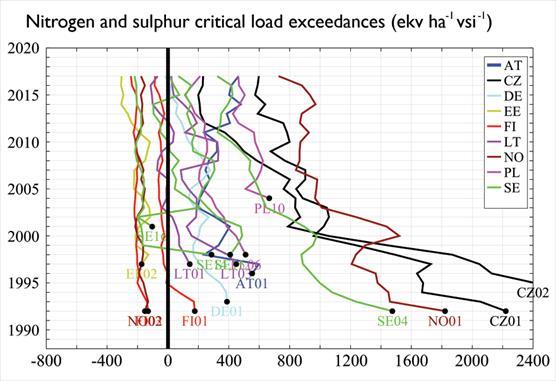
Deposition measurement station at Valkea-Kotinen monitoring area. The station is a part of ICP Integrated Monitoring network and the area has been a subject of long-term air pollution and ecosystem effect research since the early 1990s. Findings from the station were analysed in the study published in Science of the Total Environment. © Martin Forsius
Successful cooperation between scientists and policymakers has significantly decreased air pollutant emissions in Europe, according to an article recently published in the Ambio journal. Sulphur dioxide emissions in Europe have decreased by 80 per cent and nitrogen emissions by 50 per cent since the 1990s. The decrease in sulphur dioxide emissions is widely considered a success story in environmental protection.
The effects of acid rain were brought into public view in the latter part of the 20th century, and in the 1980s in particular acid rain was considered to be one of the largest environmental threats of the time. Scientific and public interest in the matter gradually led to coordinated policy actions and emission reductions in Europe and North America.
Scientists and institutions from Finland and other Nordic countries established an expert group to conduct research on the long-distance transport of sulphur compounds in Europe in the early 1970s. The research found that because emissions are not bound by country borders, the air quality in European countries is dependent on the emissions from other countries. The research paved the way for European cooperation and led to the launch of monitoring programmes for air quality and ecosystem effects and finally the UNECE Convention on Long Range Transboundary Air Pollution, CLRTAP (also known as Air Convention). The convention, signed in 1979, obliged the participating countries to take far-reaching actions in order to cut their emissions. Today, air pollutant emissions are also regulated by the EU.

Left: Monitoring areas and the estimated exceedance of critical loads for eutrophication of the study published in Science of the Total Environment. Red areas mark the highest risk for exceedance and negative effects. Right: The overall nitrogen deposition from 1880 to 2020 (cumulative result). The deposition quality estimates are used to assess critical load exceedances and ecosystem effects. © SYKE
Deposition damages vegetation and kills fish
Nitrogen and sulphur emissions released in human activities acidify the environment and damage ecosystems. This is caused by rainfall containing the pollutants finding its way to the soil and water bodies. Acidification causes chemical alterations in the soils and waters causing damages to forest vegetation and fish deaths. Nitrogen compounds contribute to eutrophication which can be detected as changes both in land and water ecosystems.
The emissions originate from various sources. Sulphur is emitted especially from energy production and manufacturing, while nitrogen oxides are mainly emitted from traffic, energy production and manufacturing. Ammonia is mainly emitted from agriculture. The most significant emission cuts have been made by reducing the sulphur emissions of energy production and manufacturing.
Long-term monitoring and modelling results inform policymakers
Long-term monitoring of environmental effects and different modelling methods help inform international negotiations and assess mitigation measures already taken.
The research has also provided information on the ecosystem effects from different kinds of pollutants. Concepts such as ‘critical load’ have been developed to illustrate the phenomena and justify decisions on emission reductions. Assessments of critical loads are used to indicate the sensitivity of ecosystems and their capacity thresholds.
“By combining information from empirical and process research as well as monitoring of environmental effects with the so-called integrated assessment models we can provide policymakers with information on cost-effective emission reduction measures. A good procedure and a culture of trust, where everyone does what is expected of them, has slowly grown between policymakers and the scientific community”, says research professor Martin Forsius from the Finnish Environment Institute.
”These experiences and tested procedures could in the future be utilised to solve other complex environmental issues such as biodiversity loss and climate change”, Forsius continues.
Information on eutrophication and acidification is collected throughout Europe. In Finland, there are several monitoring stations where information on various compounds and their effects on nature is collected continuously. The monitoring stations have also served as platforms to exhibit the activities and inform policymakers, the media and NGO representatives about scientific research.

Monitoring results from a lake at Valkea-Kotinen research area. The levels of sulphate that causes acidification have reduced 60 per cent from the year 1990, which means that the water’s alkalinity i.e. buffering against acidification is rising. Nitrate nitrogen causes acidification and eutrophication, but its levels have stayed low because the soil and vegetation of the area retains it well. © SYKE
An international research group led by the Finnish Environment Institute has developed the concepts of critical loads for eutrophication and acidification and assessed their exceedances. The results were recently published in the Science of the Total Environment journal. Emission reductions have made a positive impact, but thresholds are still exceeded in many places, particularly regarding nitrogen deposition. Long-term data of 17 forested catchments in Europe were used in the study. The research team also found that critical load methods are useful tools for both monitoring impacts and directing actions.
”The findings show that emission reductions are producing the results they were aimed at”, Forsius says.

The figure shows how the critical load exceedances of nitrogen and sulphur have reduced in the research area since the year 1990. In order to picture both critical loads in the same figure, the values are presented in equivalents (ekv/ha/a). A negative number indicates no exceedance of critical load. The findings, published in the Science of the Total Environment journal, show that air pollution control has been effective. © SYKE
Emissions pose a threat to human health
Even though emission reductions have been successful, the effects of eutrophication and acidification of natural environments are going to continue for decades to come. Air pollution is also a major cause of health issues and premature deaths, even in Europe. Pollution cuts are mentioned in several UN Development Goals.
The history of air pollution reductions has shown that science-based policymaking is most effective when there is an abundance of high-quality information. This information can be used to solve specific problems, make coordinated actions and assess the results.
More information
Attached files